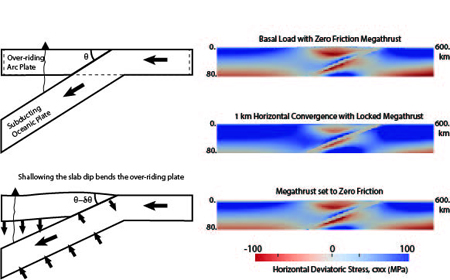
The Mechanics of Extension in Very Different Areas of Plate Convergence:
Reverse Subduction Exhuming Ultra-High Pressure Rocks in New Guinea
- and -
Normal Faulting and Tsunami generation during the Tohoku-Oki Earthquake
By:
W. Roger Buck
Lamont-Doherty Earth Observatory
Click for a Live Broadcast.

Abstract
The controversy over the exhumation of ultra-high pressure (UHP) rocks centers on whether it involves rising of pieces of crust detached from subducted continental lithosphere or an entire subducted plate that undergoes "eduction", i.e. reverse subduction. A new thermomechanical model of continental subduction shows that these apparently contrasting mechanisms can occur together: Crust subducted deep enough is heated and weakened, causing limited diapiric rise, while crust subducted to shallower depths retains strength and is exhumed only by eduction.
The model also shows for the first time how eduction followed by seafloor spreading can occur in a zone of regional convergence. This occurs spontaneously when subduction of buoyant crust causes a subduction zone to "lock up" in one place causing a new subduction zone to form in another. The model is consistent with many features of the youngest region of UHP rock exhumation on earth: the D'Entrecasteaux Islands of Papua New Guinea.
The Tohoku-oki earthquake was not only the costliest natural disaster in history it was the best monitored. Several observations suggest that the massive near-trench seafloor motion that produced the huge tsunami was linked to normal fault offset. Also, for the first time it was shown that a large subduction earthquake was followed by extensional aftershocks in a broad region of the upper plate. Inspired by the Tohoku data, researchers have searched for and found upper plate extensional aftershocks associated with several other subduction earthquakes that produced large tsunami. Numerical models show that a long-term reduction in slab dip can generate enough extensional stress to cause normal faulting over a broad region of the upper plate. During the inter-seismic period, when the subduction interface is locked, extensional fault slip is suppressed by the relative compression of the upper plate. The relief of compressional stresses during dynamic weakening of the megathrust triggers a release of bending-related extensional strain energy. This mechanism is analogous to the breaking of a pre-stressed concrete beam supporting a bending moment when the compressional pre-stress is removed.




